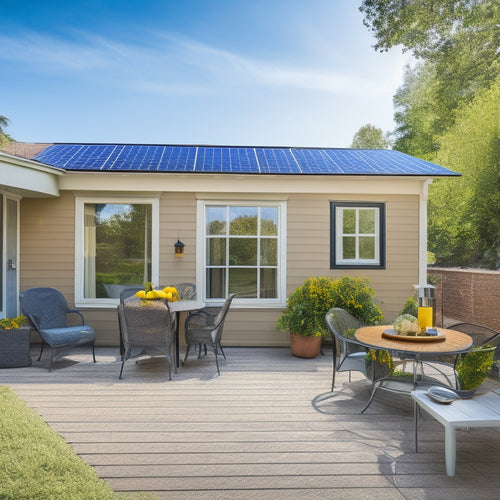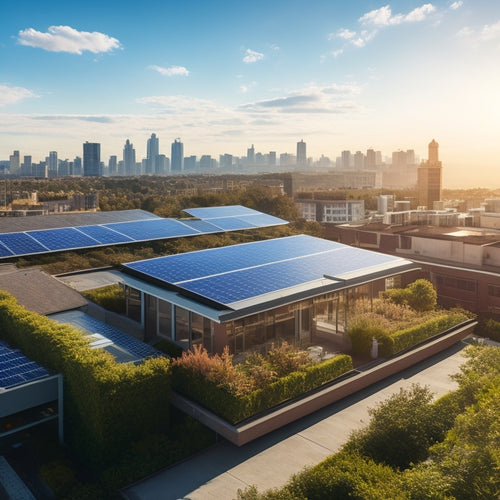
Designing and Installing a Residential Solar Panel System
Share
To successfully design and install a residential solar panel system, you'll need to start by evaluating your energy needs, reviewing past utility bills to determine average monthly energy usage, and considering sustainability goals and potential solar energy benefits. Then, choose the right equipment, prioritizing high-efficiency components and guaranteeing compatibility for seamless integration. Optimize panel layout, determine electrical configuration, and verify compliance with local building codes and safety standards. Finally, select an installation method, connect to the grid, and submit applications for grid connection and approval. As you continue to investigate the process, you'll uncover the intricate details that make a solar panel system shine.
Key Takeaways
- Assess energy needs by reviewing past utility bills and considering sustainability goals to determine the ideal system size and configuration.
- Choose high-efficiency solar panels and inverters based on efficiency ratings, cost analysis, and warranty durability to maximize energy output.
- Design the solar array by optimizing panel layout, electrical configuration, and inverter type to ensure compliance with local building codes and safety standards.
- Select the right installation and mounting option (roof-mounted, ground-mounted, or hybrid) based on roof type, local building codes, and available space.
- Complete the grid interconnection process by installing a net meter and submitting an application to the utility company to link the solar system to the grid.
Assessing Your Energy Needs
Most homeowners consume around 900-1,000 kilowatt-hours (kWh) of electricity per month.
To evaluate your energy needs, you'll need to ascertain your own energy consumption patterns. Review your past utility bills to get an idea of your average monthly energy usage. This will help you understand how much electricity you need to generate to meet your energy needs.
Reflect on your sustainability goals and how solar energy can help you achieve them. You may be eligible for solar incentives, such as tax credits or rebates, which can offset the cost of installing a solar panel system.
When designing your system, think about system maintenance and how you'll guarantee your system is running efficiently over time. You may also want to contemplate future expansion, in case you need to add more panels or upgrade your system.
Choosing the Right Equipment
When designing your residential solar panel system, two to three key components require careful consideration: solar panels, inverters, and mounting systems.
You'll need to choose the right solar panel types for your system, considering factors like efficiency ratings and cost analysis.
Next, inverter selection is vital, as it converts DC power from the panels to AC power for your home.
Here are three important considerations for your equipment:
-
Efficiency and Performance: Look for high-efficiency solar panels and inverters to maximize your energy output.
-
Warranty and Durability: Confirm your equipment comes with thorough warranties and is built to last, reducing maintenance and replacement costs.
-
Compatibility and Integration: Verify that your chosen components are compatible and integrate seamlessly, including any battery storage solutions you may want to add.
Designing the Solar Array
Three key aspects of designing your residential solar panel system's solar array are panel layout, electrical configuration, and structural integrity.
When designing the panel layout, you'll need to take into account the site orientation and any potential shading issues. A shading analysis will help you identify areas where trees, buildings, or other obstructions may cast shadows on your solar panels, reducing their energy output. By taking these factors into account, you can optimize the layout to maximize energy production.
Electrical configuration involves determining the number of panels, their wattage, and how they'll be connected to guarantee efficient energy transmission. You'll need to decide on the inverter type, string configuration, and grounding method. It's crucial to verify that your electrical configuration meets local building codes and safety standards.
Structural integrity is critical to confirm your solar array can withstand various weather conditions, including high winds and heavy snow loads. You'll need to assess the roof's condition, determining if it's suitable for solar panel installation or if additional structural support is required.
Installation and Mounting Options
Having refined your solar array's design, you're now ready to evaluate the installation and mounting options that will bring your system to life.
When it comes to installation, you'll need to take into account factors such as roof types, weather considerations, and local building codes. For instance, asphalt shingle roofs are a popular choice, but metal or tile roofs may require specialized mounting brackets.
You'll also need to decide between roof-mounted and ground-mounted systems. Here are three key factors for each option:
-
Roof-mounted systems: Ideal for homes with ample roof space, these systems are often more cost-effective and easier to install.
-
Ground-mounted systems: Suitable for homes with limited roof space or obstructions, these systems offer greater flexibility and easier maintenance.
-
Hybrid systems: Combining roof-mounted and ground-mounted components, these systems provide maximum energy output and flexibility.
Before installation, be sure to secure necessary installation permits and follow local regulations.
Finally, keep in mind that regular maintenance is essential to guarantee the best system performance.
Connecting to the Grid
Your solar panel system is now installed and ready to generate electricity, but it's not yet connected to the grid. This connection is essential to enjoy the full benefits of your solar panel system.
The grid interconnection process involves linking your system to the utility grid, allowing you to sell excess energy back to the grid and offset your electricity bills. To achieve this, you'll need to install a net meter, which measures the difference between the electricity you produce and consume.
The net metering benefits are twofold. To begin with, you'll reduce your reliance on the grid during peak hours, and in addition, you'll generate credits for excess energy produced, which can be used to offset your energy consumption during periods of low solar production.
The grid interconnection process typically involves submitting an application to your utility company, followed by an inspection and approval process. Once approved, your system will be connected to the grid, and you'll start enjoying the benefits of net metering.
Frequently Asked Questions
Can I Install Solar Panels on a Metal or Asphalt Roof?
You can install solar panels on a metal or asphalt roof, but you'll need to evaluate roof compatibility and installation factors, like guaranteeing a secure mount and adequate drainage, to guarantee a safe and efficient system.
Are Solar Panels Prone to Hail Damage or Other Weather Events?
You might be surprised to know that 99% of solar panels survive hail storms unscathed! When it comes to weather durability, you'll find that modern solar panels are designed with hail resistance in mind, ensuring they can withstand Mother Nature's toughest tests.
How Long Does It Take to Pay off a Residential Solar Panel System?
You're likely wondering how long it takes to pay off a residential solar panel system. The payback period varies, but with financing options like loans or leases, you can start saving on energy bills immediately, often breaking even within 5-10 years.
Can I Sell My Excess Energy Back to the Utility Company?
As you capture the power of the sun, you're probably wondering: can you sell excess energy back to the utility company? Yes, through net metering benefits, you can, and with energy credit options, you'll be rolling in credits, feeling like a valued contributor to the grid!
Do Solar Panels Require Regular Maintenance and Cleaning?
You'll want to clean your solar panels regularly to maximize energy output; follow maintenance tips like inspecting for debris, using a soft brush, and rinsing with distilled water to guarantee ideal performance and extend their lifespan.
Conclusion
You've made it! You've assessed your energy needs, chosen the right equipment, designed the solar array, and installed it with care. Now, as you connect to the grid, remember that every wire, every panel, and every component works in harmony to bring you clean energy. Just as each piece of the system relies on the others, your commitment to sustainability relies on every choice you make. With your new residential solar panel system, you're generating more than power - you're generating a better future.
Related Posts
-

10 Essential Bike Lane Safety Features to Consider
You're designing a bike lane with safety in mind, and that's essential. The National Highway Traffic Safety Administr...
-

10 Tips to Buy Affordable Solar Panels Online
When purchasing affordable solar panels online, you'll want to research reputable retailers, compare prices, and chec...
-

What Is the Cost to Put in Solar Panels
You're likely considering solar panels for your home, and the most significant factor in your decision is the upfront...


